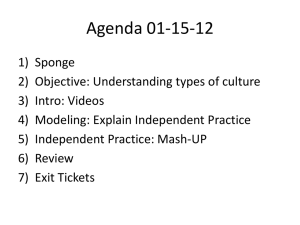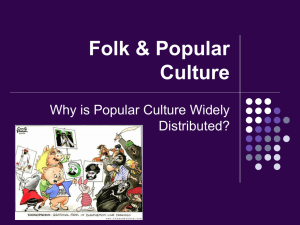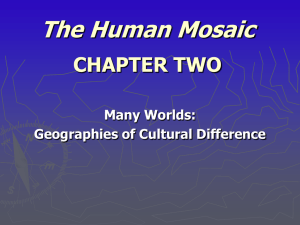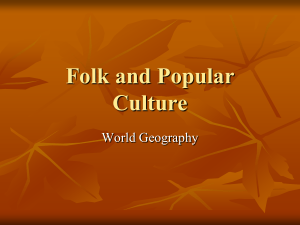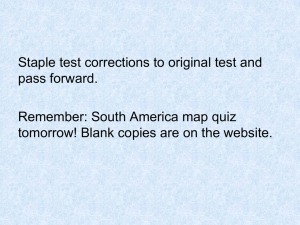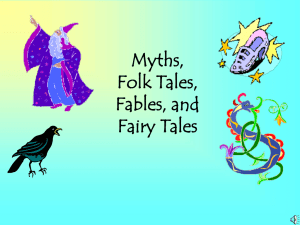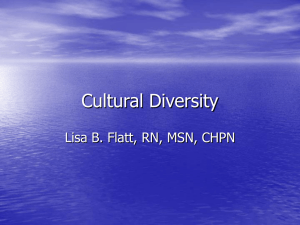Folk & Popular Culture Study Guide - AP Human Geography
advertisement
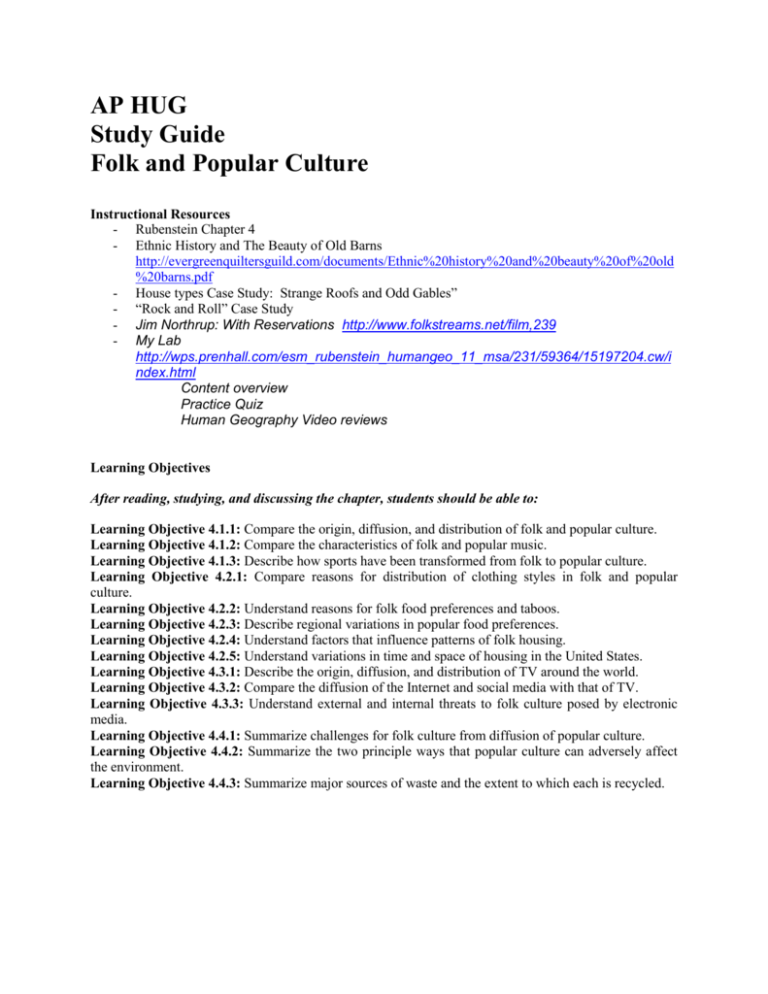
AP HUG Study Guide Folk and Popular Culture Instructional Resources - Rubenstein Chapter 4 - Ethnic History and The Beauty of Old Barns http://evergreenquiltersguild.com/documents/Ethnic%20history%20and%20beauty%20of%20old %20barns.pdf - House types Case Study: Strange Roofs and Odd Gables” - “Rock and Roll” Case Study - Jim Northrup: With Reservations http://www.folkstreams.net/film,239 - My Lab http://wps.prenhall.com/esm_rubenstein_humangeo_11_msa/231/59364/15197204.cw/i ndex.html Content overview Practice Quiz Human Geography Video reviews Learning Objectives After reading, studying, and discussing the chapter, students should be able to: Learning Objective 4.1.1: Compare the origin, diffusion, and distribution of folk and popular culture. Learning Objective 4.1.2: Compare the characteristics of folk and popular music. Learning Objective 4.1.3: Describe how sports have been transformed from folk to popular culture. Learning Objective 4.2.1: Compare reasons for distribution of clothing styles in folk and popular culture. Learning Objective 4.2.2: Understand reasons for folk food preferences and taboos. Learning Objective 4.2.3: Describe regional variations in popular food preferences. Learning Objective 4.2.4: Understand factors that influence patterns of folk housing. Learning Objective 4.2.5: Understand variations in time and space of housing in the United States. Learning Objective 4.3.1: Describe the origin, diffusion, and distribution of TV around the world. Learning Objective 4.3.2: Compare the diffusion of the Internet and social media with that of TV. Learning Objective 4.3.3: Understand external and internal threats to folk culture posed by electronic media. Learning Objective 4.4.1: Summarize challenges for folk culture from diffusion of popular culture. Learning Objective 4.4.2: Summarize the two principle ways that popular culture can adversely affect the environment. Learning Objective 4.4.3: Summarize major sources of waste and the extent to which each is recycled. Chapter Outline Key Issue 1: Where Are Folk and Popular Leisure Activities Distributed? Culture is defined as a collection of social customs; customs are repetitive acts of groups. Repetitive acts of individuals are called habits. We will focus on two facets of material culture: (1) culture deriving from the necessities of daily life such as food, clothing and shelter, and (2) leisure activities such as the arts and recreation. This unit will outline the two major categories of material culture: folk and popular culture. Folk culture and popular culture differ in their patterns of origins, diffusion, and distribution. Folk culture is practiced by small homogenous groups living in isolated rural areas. Popular culture is found in large heterogeneous societies that share certain customs despite differences in other personal characteristics. Origin Customs originate from hearths. Folk customs are often anonymous while popular customs originate in more developed countries as part of the market for recreational (leisure) and disposable income to purchase these material goods. Diffusion Popular culture diffuses (usually hierarchically) through rapid electronic communications and transportation networks. Folk culture diffuses across space through relocation diffusion and across time through cultural transmission. Distribution Popular culture is distributed widely across many countries, with little regard for physical factors. Folk cultures often (though not always) incorporate elements of the local environment. Groups with relatively little contact with others develop unique folk cultures. Himalayan religious art is used as an example of how isolated religious groups depict the same environment much differently in their art. Ojibwa seasonal practices are viewed as unique elements to N. Minnesota and Wisconsin. Folk Music The purpose of folk music is to tell stories or to disseminating information. Folk music typically originates from an anonymous hearth. As people migrate, folk music travels with them as part of the diffusion of folk culture. Popular Music Popular music is deliberately written to be sold and performed. While some forms of popular music contain references to local places or events, the purpose of the music is still to appeal to a variety of people across Earth. As with other elements of popular culture, popular musicians have more connections with performers of similar styles, regardless of where in the world they happen to live, than they do with performers of different styles who happen to live in the same community. In the past musicians clustered in particular communities according to their shared interest in specific styles. Because of the globalization of popular music, musicians are less tied to the culture of a particular place. Now musicians cluster in communities where other musicians reside regardless of the style of music they play. Origin and Diffusion of Popular Sports Soccer is an example of a popular folk custom that was popularized and then globalized. The hearth of soccer is believed to be in England in the eleventh century. In the 1800s, soccer transformed from a folk custom to a popular culture. Several English soccer clubs formed an association to standardize the rules and to organize professional leagues. Spectators started to pay to see first-class events. Soccer then diffused to other parts of Europe. Soccer later diffused to other parts of the world by new communication systems such as the radio and TV. Other sports are similar to soccer as elements of popular culture, though the distribution of each sport is different. If a sport becomes popular enough worldwide, it becomes part of the Olympics. For a sport to be to be included in the Olympics it must be widely played in at least 75 countries (50 countries for women sports) and on four continents. Surviving Folk Sports Most other sports have diffused much less than soccer. Cricket, wushu, baseball, and lacrosse are examples of sports that never became very popular globally. Key Issue 2: Where Are Folk and Popular Material Culture Distributed? Folk Clothing Preferences People wear distinctive folk clothing for a variety of environmental and cultural reasons. Women who live in countries in Southwest Asia and Northern Europe are discouraged from wearing popular casual Western-style clothing because of religious reasons. On the other hand, some European countries prohibit women from wearing traditional clothing from Southwest Asia and North Africa because the leaders in government believe that those clothes make women seem like second class citizens. Rapid Diffusion of Popular Clothing Styles Popular clothing habits have little regard for the climate or topography of an area. Because of the sufficient incomes, the social desirability of dressing for a particular job or social class, and rapid communications, popular clothing styles can change several times per year across the more developed world. Jeans are an example of how Western popular culture has diffused to other countries. Jeans retain local diversity because different regions of the world prefer a particular style of jeans. Folk Food Customs and the Environment The local climate presents a major influence on what can and cannot be grown. The contribution of a location’s distinctive physical features to the way food tastes is known as terroir. Folk cultures have had to adapt their food preferences to conditions in their local environment and this has created distinctive local cuisines around the world. Folk cultures will also eat certain foods that are believed to enhance qualities that are considered desirable by their society. Food Taboos The development of food taboos are thought to be partly environmental and partly cultural. These taboos may help to protect endangered animals or to conserve scarce natural resources. Many religions have food taboos because they protected the environment of the religion’s hearth. Social values can also influence what people eat because people in similar climates and with similar levels of income consume different foods. Popular Food Culture Popular foods and beverages display regional variation depending on what can be locally produced and other cultural influences. Wine serves as a global example, as it is globally popular but not as common in areas which cannot support grapes or where a large part of the population does not consume alcohol. The distinctive character of a wine derives from the vineyard’s unique combination of soil, climate, and other physical attributes. Environmental Influences on Folk Housing Folk housing styles are another example of the influence of the physical environment, with housing design reflecting both cultural norms and environmental influences from the type of building material used to the shape of the house to more efficiently heat, cool, or shed water. Even in areas that share similar climates and available building materials, folk housing can vary because of minor differences in environmental features. Sacred Spaces in Houses Some folk housing distinctive design may also derive primarily from religious values and other customary beliefs. Houses in some folk cultures may have sacred walls or corners. Compass direction may play a big role in how the house was built and how the interior of the house is arranged. U.S. Folk Housing Older houses in the United States from the east coast toward the Mississippi River display a local folk-culture tradition. The distribution of U.S. folk housing styles reflected whatever style was prevailing at the place on the East Coast from which the people migrated from. New housing styles in the United States are increasingly based on popular notions of what a house should look like, which changes over the decades. U.S. Popular Housing The degree of regional differences in housing types in the United States has diminished because rapid communication and transportation systems provide people throughout the country with knowledge of the different styles. A variety of housing styles have come and gone in the United States since the end of World War II. Key Issue 3: Why Is Access to Folk and Popular Culture Unequal? Diffusion of TV: Mid-Twentieth Century Popular culture is diffused faster and further than ever with the invention and diffusion of forms of electronic communication like television. Television allows images and messages about popular culture to spread instantaneously across the globe. Several decades ago, a large percentage of the world’s people did not have access to a television because of their lack of income, electricity, or service. Watching TV is now the most popular leisure activity in the world. The technology by which television is delivered is changing throughout the world. Diffusion of the Internet: Late Twentieth Century Internet service has diffused at a rapid pace throughout the world. It has diffused much faster than TV did. It is likely to diffuse even further in the years ahead. Diffusion of Social Media: Twenty-First Century People in the United States have dominated the use of social media during the early years. Social networking websites like Facebook, Twitter, and YouTube still enjoy their greatest popularity in the United States, but are quickly diffusing to other countries. External Threat: Developed Countries Control the Media Since media outlets are largely Western (especially television programming), their content may present values or beliefs in conflict with those of a particular place receiving those broadcasts. Government may perceive this Western control as a threat to their national systems and attempt to restrict the programming available to the populace. Internet Threat: Social Media In some places around the globe residents have sought out Western programming otherwise not available through the use of satellite dishes. Governments around the world are also trying to limit the Internet content in their countries. Social media has started to play an even more significant role in breaking the monopoly of government control over the diffusion of information. Key Issue 4: Why Do Folk and Popular Culture Face Sustainability Challenges? The Amish: Preserving Cultural Identity The Amish are an example of a group in the United States that shuns any mechanical or electrical power. The globalization of popular culture represents to many people in folk cultural societies a loss of traditional values. Many fear the loss of folk culture, especially because of the rising demand for possessions of a popular culture. For folk culture, increased connection with popular culture can make it difficult to maintain centuries-old practices. Folk societies are trying hard to maintain their unique culture in an age of globalization. The Ojibwa: Traditional practices and language preservation The Ojibwa in Northern Minnesota and Wisconsin face a variety of sustainability challenges. Off reservation opportunities serve as pull factors for young Ojibwa faced with few economic opportunities on reservations. Access to land for traditional practices such as spear fishing, ricing, hunting, etc. has been squeezed by development. Loss of Ojibwa language speakers degrades an important cultural transmission pathway. Finally, the advent of casinostyle gaming provides attractive alternatives to traditional folk culture activities. Marriage in India: Challenging Cultural Values The global diffusion of popular culture has challenged the subservience of women that is embedded in some folk cultures. This has been both a good thing and a bad thing for women in developing countries. The family of the bride in India is sometimes expected to provide the groom with a dowry. Some women in India have actually been killed because their family did not pay a large enough dowry to the groom. Landscape Pollution Although folk culture is not automatically mild in environmental impact, popular culture tends to ignore local environments because of its spatial extent, including the modification of the natural environment. Another impact of popular culture is the creation of uniform landscapes, which many consider unattractive compared to locally diverse landscapes. Uniformity in appearance of the landscape is promoted by structures like gas stations, supermarkets, fast-food restraints, and motels. Golf courses require large expanses of open, carefully managed grass. Some golf courses are designed partially in response to local physical conditions. Many courses have little regard for local conditions and usually dramatically alter the natural landscape of an area. Golf course remake the environment by creating of flattening hills, cutting grass, carting in or digging up sand for traps, and draining or expanding bodies of water to create hazards. Resource Depletion Popular customs may also involve the overuse and depletion of scarce natural resources. The increased demand for meat is leading to a decrease in the total amount of grain available. Pollution often times results from popular cultural practices. Recycling consumer products is helping to alleviate all the unwanted by-products that usually end up in landfills or burned in incinerators. Assignment 1- Due On Mon. 1/25 Rubenstein Reading and discussion Questions Key Issue 1: Where Are Folk and Popular Leisure Activities Distributed (pp. 108-115)? Learning Objective 4.1.1: Compare the origin, diffusion, and distribution of folk and popular culture. Learning Objective 4.1.2: Compare the characteristics of folk and popular music. Learning Objective 4.1.3: Describe how sports have been transformed from folk to popular culture. Reflection Questions: 4.1.1: What geographic factors account for the diversity of cultures in the Himalayas? 4.1.2: What type of popular music do you like? Where does it fit in the popular music maps? Thinking Geographically: 4.1: In what ways might gender affect the distribution of leisure activities in folk or popular culture? Google Earth Question p. 138: GOOGLE EARTH 4.1: Connections among Nepal’s diverse folk culture groups are hindered by what feature of the physical environment? What does the white represent in the image of Nepal? Assignment 2- Due On Tuesday. 1/26 Rubenstein Reading and discussion Questions Key Issue 2: Where Are Folk and Popular Material Culture Distributed (pp. 116-125)? Learning Objective 4.2.1: Compare reasons for distribution of clothing styles in folk and popular culture. Learning Objective 4.2.2: Understand reasons for folk food preferences and taboos. Learning Objective 4.2.3: Describe regional variations in popular food preferences. Learning Objective 4.2.4: Understand factors that influence patterns of folk housing. Learning Objective 4.2.5: Understand variations in time and space of housing in the United States. Reflection Questions: 4.2.1: Can you think of other restrictions on clothing styles in developed countries, perhaps in schools? 4.2.2: What foods do you avoid? Do you avoid foods because of taboos or for other reasons? 4.2.3: Do your food preferences match the predominant ones in your region? 4.2.5: Can you describe your house through reference to one of the past or present styles? Thinking Geographically: 4.2: Which elements of material culture do countries depict in campaigns to promote tourism? Google Earth Question p. 138: GOOGLE EARTH 4.2: Rüdesheim, Germany, a wine-producing community, is surrounded by hillside vineyards. Towards which direction (east, west, north, or south) do most of these vineyards slope, and how does this orientation maximize exposure to sunlight? Assignment 3- Due On Wednesday, 1/27 Rubenstein Reading and discussion Questions Key Issue 3: Why Is Access to Folk and Popular Culture Unequal (pp. 126-131)? Learning Objective 4.3.1: Describe the origin, diffusion, and distribution of TV around the world. Learning Objective 4.3.2: Compare the diffusion of the Internet and social media with that of TV. Learning Objective 4.3.3: Understand external and internal threats to folk culture posed by electronic media. Reflection Questions: 4.3.1: How much TV do you watch? Which type of programs do you watch? Do you watch on a traditional TV set, or do you watch on a computer, tablet, or smart phone? 4.3.2: Which social media do you prefer to use? Why? 4.3.3: What would be a specific example of a distinctively American perspective on a U.S. TV show? Thinking Geographically: 4.3: Which elements of the physical environment are emphasized in the portrayal of places on TV? Google Earth Question p. 139: GOOGLE EARTH 4.3: Kathmandu, Nepal, situated at the foot of rugged mountains, is one of the world’s most physically isolated capitals. TripAdvisor considers BoudhaNath Stupa to be the top attraction in Kathmandu. Using the Find Business and ruler features of Google Earth, how far is it from the stupa to the nearest Internet café? Assignment 4- Due On Thursday, 1/28 Rubenstein Reading and discussion Questions Key Issue 4: Why Do Folk and Popular Culture Face Sustainability Challenges (pp. 132-137? Learning Objective 4.4.1: Summarize challenges for folk culture from diffusion of popular culture. Learning Objective 4.4.2: Summarize two principle ways that pop culture can adversely affect the environment. Learning Objective 4.4.3: Summarize major sources of waste and the extent to which each is recycled. Reflection Questions: 4.4.1: In what ways might the Amish need to interact with popular culture? 4.4.2:. How might fast-food restaurants reduce adverse impacts on the environment? 4.4.3: Which, if any, recycling systems operate in your community? Thinking Geographically: 4.4: Are there examples of groups in North America besides the Amish that have successfully resisted the diffusion of popular culture? Google Earth Question p. 139: GOOGLE EARTH 4.4: Paradise, Pennsylvania, is in the heart of Amish country. If you fly to 269 Old Leacock Road in Paradise and drag to street view, what distinctive feature of Amish culture is visible? Final Review/ Reflection Questions (Group Roundtable Disc.) Describe a distinctive food preference that your family has and trace its origins to a folk hearth. If you don’t have one, use an example that you’ve heard or seen (not from the book). List some of your food taboos and give an explanation for each. How many have to do with cultural traditions you’ve inherited, and how many have to do with cultural views you’ve adopted as an adult? Social websites like Facebook, Twitter, and YouTube are changing the way that popular and folk cultures are diffused. Give and support an argument for how the Internet might aid the preservation, or even expansion, of some folk cultural elements. Describe one activity of popular culture that you engage in and evaluate its impact on the environment. What might a folk cultural alternative to your activity be? Describe a personal habit, a custom that you follow that is not generically “popular culture,” and a culture that you follow. Be sure to define and explain each one, and then try to explain where each one originated. Do you consider your culture to be part of the “dominant” culture at this school? If “yes,” explain how you observe other cultures and why you make these observations. If “no,” explain how the dominant culture influences your own culture. Assignment 5- Due On Thursday, 1/28 My Lab Human Geography Video Reviews View three of the following on MyLab. For each segment provide a description of the Folk culture, sociofacts, mentifacts and artifacts. In addition describe the elements of impact of mass culture that have crept into the society in question and the impact of that diffusion. TVE: Geraldo's Brazil New! — BBC: Bhutan: Around the World: The Kingdom of Bhutan New! — BBC: Human Impacts on Water Resources New! — BBC: Iraq: Ancient Lives — The Marsh Arabs New! — BBC: Israel: Our Land or Their Land? The Bedouin of the Negev Desert New! — BBC: Kenya: The Turkana Way of Life New! — BBC: Mongolia: Ancient Lives — The Mongols New! — BBC: Namibia: Ancient Lives — The Bushmen Resources American Cultural History, 19th and 20th Centuries Entertaining and informative details of American popular culture from the last 200 years. Produced by Kingwood College Library references librarians, Kingwood, Texas. kclibrary.lonestar.edu/19thcentury.html (Note: not all pages currently link to the correct decade. You may have to append the directory yourself, e.g. /19thcentury1860.htm). Encyclopedia Smithsonian: American Social and Cultural History http://www.si.edu/encyclopedia_si/nmah/ Exhaustive resource for American Social and Cultural History
